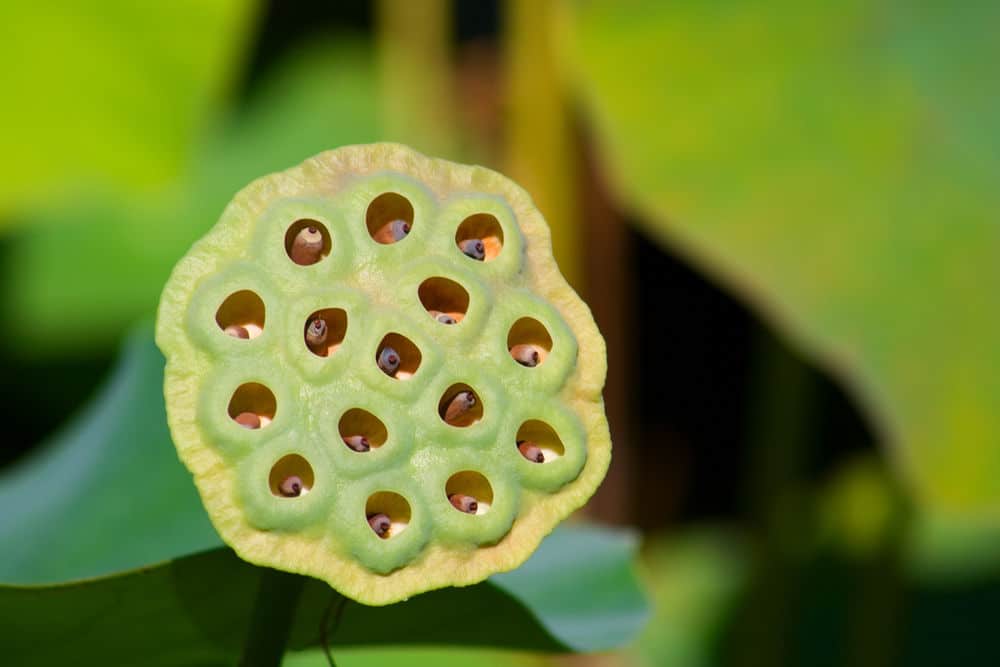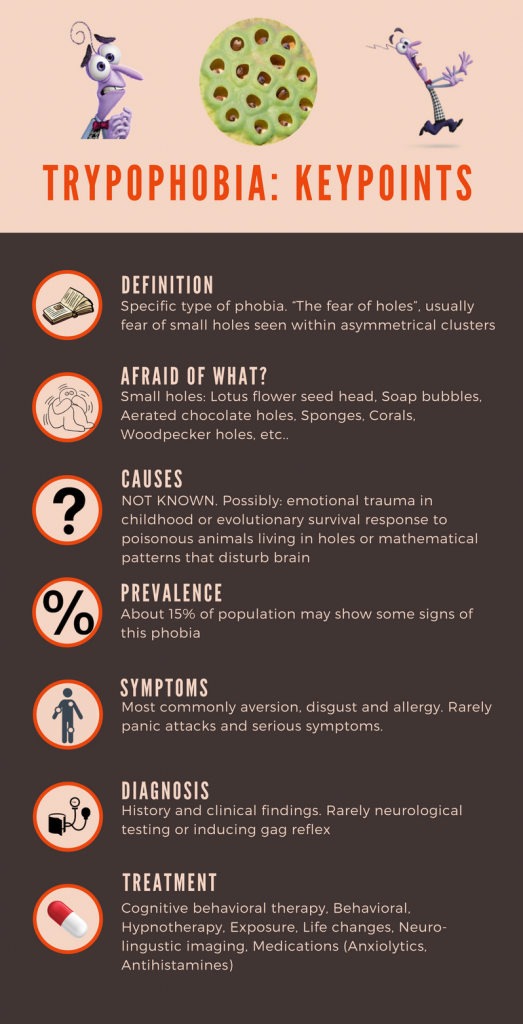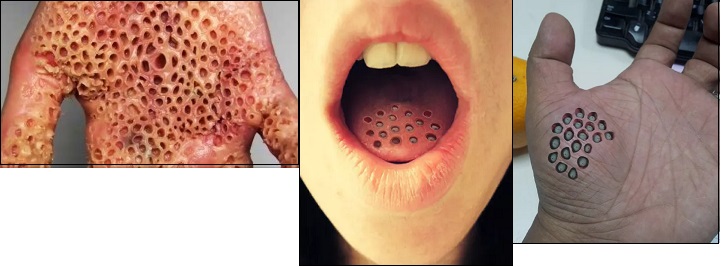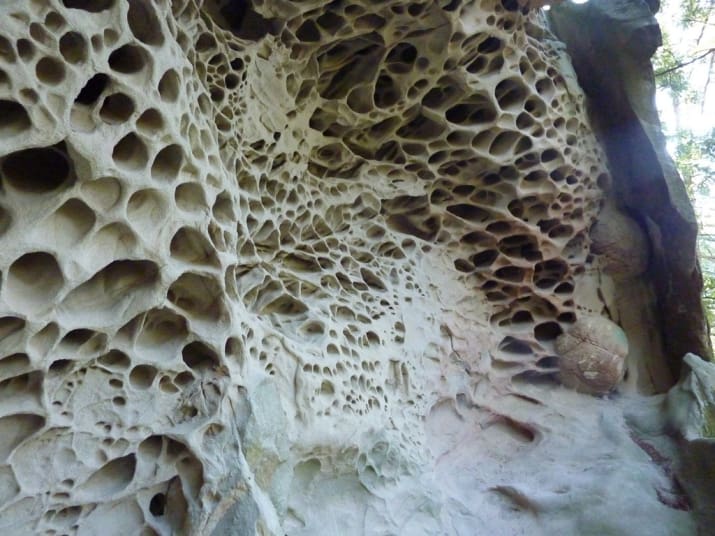Contents
- What is Trypophobia?
- Trypophobia pronunciation and word origin
- Is trypophobia a skin disease?
- How common is trypophobia?
- What are patients with Trypophobia afraid of?
- Trypophobia case reports
- What causes trypophobia?
- Evolutionary survival response theory of trypophobia development
- New mathematical theory of trypophobia development
- Trypophobia signs and symptoms
- Trypophobia diagnosis and tests
- Trypophobia treatment
- Cognitive behavioral therapy (CBT) for trypophobia
- Hypnosis for trypophobia
- Exposure therapy for trypophobia
- Morita therapy for trypophobia
- Medications for trypophobia
- Neuro-Linguistic programming therapy
- Yoga, meditation, or some other relaxation technique for trypophobia
- Lifestyle changes for trypophobia
- Share your fear with family and best friends
- How long trypophobia usually lasts?
- Trypophobia prevention
Contains disturbing graphics
What is Trypophobia?
Trypophobia or “the fear of holes” is a specific type of phobia under anxiety disorder characterized by persistent, irrational and intense fear of holes, usually not the huge ones but the small holes seen within asymmetrical clusters. According to Cole and Wilkins article published in Psychological Science 2013, trypophobia is the disgust response or unpleasant feeling often accompanies with somatic responses (e.g., goose bumps) made by observing a cluster of innocuous objects such as for example lotus seed pods.
Although to average person this phobia may look funny, one study also published in Psychological Science has estimated that trypophobia is present in even 16% of people. The study described that the condition may provoke very intense reaction, even though “the stimuli are usually groups of holes of any type that are almost always harmless and seemingly pose no threat.” The intensity of the fear varies from person to person.
While some persons may find that hole clusters causes them to feel very uncomfortable, others claimed that just a look at images can be so frightened to them that make them to shake all over in fear.

Trypophobia pronunciation and word origin
Trypophobia is pronounced as (Try-Poh-Foe-Be-Uh) .
The word trypophobia comes from Greek word τρύπα, trýpa, meaning “hole” and φόβος, phóbos, meaning “fear”.
Is trypophobia a skin disease?
No, trypophobia is not a skin disease. It is specific phobia, a subtype of anxiety disorder. Pictures you saw on the internet like these below are photoshoped!
However, holes, especially those in organic objects that can be caused by various skin diseases such as blisters or rash related with measles or chicken pox may subconsciously remind us of the symptoms of contagious skin diseases.
Also one more skin condition can be caused by black flies, which carry a parasitic worm that causes thickening of the skin. In overacting individuals, these images of such skin conditions may cause trypophobia to occur, and to further connect in future every similar cluster “hole” formation with such skin diseases.
How common is trypophobia?
One study, published Psychological Science has estimated that trypophobia with different range of severity is present in about 16 % of people. So, according to this it is very common type of phobia
In order to find out initial estimation of how common trypophobia is, one case report study asked 286 adults (91 male and 195 female) who were 18–55 years old to view an image of the lotus seed head. The participants need to answer whether the image was “uncomfortable or even repulsive to look at.” Results were following:
- 10 males (11%) reported aversions
- 36 females (18%) reported aversions
Since there has been a very little investigation on this phenomenon, some scientists that trypophobia may be the most common phobia you have never heard of.

What are patients with Trypophobia afraid of?
Sufferers of trypophobia usually report aversions to visual stimuli embracing particular configurations of holes. There are a number of Internet-based support groups, including a Facebook group (https://www.facebook.com/groups/3318322299/), where trypophobia sufferers provide testimonials. These testimonials show that trypophobia significantly affects their everyday lives and routines so it can be very debilitating.
The image that will most trypophobiacs report provoking the phobia is the lotus flower seed head. Other also well-known examples may include soap bubbles and the aerated chocolate holes. Sufferers from this phobia usually report that the visual perception is particularly very aversive.
Additionally, the severity of trypophobia seems to be more severe if the holes occur on human skin for example: the skin prints of stones after sitting on sand. It is only in this respect that the phobia involves any reference to the semantics of the image. The visual nature of trypophobia provides a clue as to its cause.
But, the fear of holes is not only associated with images, some persons may also fear holes in pores on the skin, meat, on vegetables or fruits. There are also cases where people fear of sponges, wood, honeycombs etc. For some individuals, even the verbal mention of phrase “fear of small holes” is enough to trigger fear. There are also persons that think that something might be living inside those holes
Following objects or images of it have triggered tryptophobia in some individuals:
- Lotus flower seed head
- Soap bubbles
- Aerated chocolate holes
- Skin prints of stones
- Sponges
- Corals
- Woodpecker holes
- Honeycombs
- Condensation drops on a bottle
- Sandstone structures
- Holes made on delicious pancakes
- Cantaloupe holes
- Holes in pomegranates
- Stretch marks on the skin after pregnancy
Etc…
Trypophobia case reports
Here are some reports of persons with trypophobia:
Person #1
“I can’t really face small, irregularly or asymmetrically placed holes, they make me like, throw up in my mouth, cry a little bit, and shake all over, deeply.”
Person #2
“Guardians of the galaxy has quite a few trypophobia triggers in it. More so near the end. Left me very itchy and had to look away at least 3 times. Otherwise it was an amazing move!”
Person #3
“I have Trypophobia and find some images easier to look at than others. They can even have more holes and I won’t bother me… BUT this only happens if the holes are aligned such as Honey combs. If they’re scattered and just everywhere, that’s what gets me! … the ones that were in straight lines I could handle very well but the ones that were randomly placed were the ones I would start to feel my anxiety rising…”
According to some data, even reality star Kendall Jenner has admitted that she struggles to look at clusters of holes, writing on her website: “Things that could set me off are pancakes, honeycomb, or lotus heads (the worst!).”
What causes trypophobia?
According to findings of Geoff Cole and Arnold Wilkins from the University of Essex, the brains of individuals with trypophobia connect the holes with some kind of danger.
However, what kind of danger trypophobiac senses or imagines is yet unknown. Other thinks that trypophobia is actually a type of basophobia or fear of falling, which is according to some scientist one of fears that we are born with (including fears of strangers, pain/death and failure).
Some psychiatrists may include following causes that can lead to trypophobia
- Deep rooted traumatic emotional problem associated with childhood may somehow trigger traumatic memories associated with holes. Possible bee allergy to stings and traumatic event from it in the past that led to a swelling wherein the swollen skin displayed every pore may be a good example why someone gets trypophobia.
- Evolution may be one of the major causes behind trypophobia. Scientists explain this cause by giving the example of “pockmarked objects” which do not seem “quite right or completely normal”. Some primitive parts of the brain don’t perceive it properly or associate these ‘pockmarks’ with something dangerous.
- Holes also tend to be related with troublesome conditions such as rashes or skin blisters that typically follow an episode of measles or chicken pox. Wilkins and Cole described this in their study a study from 2013. They claimed that it is instinctual to associate different shapes with danger, as the brain naturally relates them with disease or wound
- Some experts think that it is human DNA to feel repelled by the repeated patterns.
Evolutionary survival response theory of trypophobia development
New research conducted by psychological scientists G. Cole and A. Wilkins of the University of Essex proposes that trypophobia may happen as a result of a particular visual feature also found among numerous poisonous animals.
According to giving survival information (in this case wrong) that we are looking at a poisonous animal, plant, or place where some animal is hiding (snakes, scorpions, spiders, bees and various insects, they are all living in holes or clusters of holes). They concluded that clusters of holes are aversive because they might share a visual feature with animals that during evolution, humans have learned to avoid as a in order to survive
One of the best proofs that support this theory is a story of one trypophobia sufferer in which he tells that he has seen an animal that caused him to experience a trypophobic reaction, and this was actually the blue-ringed octopus.
New mathematical theory of trypophobia development
In most cases of trypophobia, holes are no obvious threat and danger. Person can’t fall in these holes and can’t get possibly injured. Also different photos that may induce the phobia do not have something in common with one another, other than their configuration.
So, it appears that actually the configuration may hold the key to the emotion that these photos can induce. It has been also shown that people without trypophobia may find trypophobic photos aversive, even they do not experience fear or any other emotion. It has been suggested that maybe configuration gives the image some mathematical properties that are shared by most images able to cause eyestrain, visual discomfort or headache.
Images with such mathematical patterns in some individuals can’t be processed efficiently by the brain and thus brain needs more oxygenation. One finding suggest that discomforts may occur specifically because people avoid looking at the images since they need excessive oxygenation of the brain. As, the brain uses about 20% of the body’s energy, there is physiology mechanism that its energy usage needs to be kept to a minimum.
So trypophobic images are among those that for some individuals are extremely uncomfortable to look at. Currently it is investigating why trypophobiacs and not others experience an emotional response.
It has been also noted that images of example skin diseases can provoke disgust in most people, which is probably an evolutionary mechanism promoting avoidance for survival value.
Results showed that images of skin lesions or mould have mathematical patterns similar to images that are trypophobics afraid of. Probably, discomfort caused in trypophobiacs is a useful mechanism for avoiding both excessive oxygenation and objects that provide a danger in terms of contamination. It may be that in trypophobiacs, this mechanism is expressed too much.
Trypophobia signs and symptoms
Patient with trypophobia may experience following signs and symptoms:
- Sensation of skin ‘crawling’
- Shuddering
- Feeling itchy
- Feeling sickened or disgusted
- Nausea and vomiting
- Bizarre thoughts of falling into the deep holes
- Sweating
- Aggression and agitation
- Compulsive thinking about holes
- Shortness of breath
- Rapid heart beats
- Panic attacks
Typical clinical representation of trypophobia is following. When the attack of trypophobia takes place, the first noticeable symptom is the paleness in skin. After this trypophobic person usually begins to sweat. In some cases allergic reactions including skin redness or bright spots on skin can be manifested as a result of the emotional reaction that occurs. Soon trypophobiac may feel weakness in limb.
Tachycardia and difficulty in breathing are also often. If the attack is not so severe the worst symptoms affected person may experience are: nausea, vomiting, headache, dizziness and agitation. If the fear continues to grow, usually heartbeat increases.
In rare cases, this quick change can result in a heart attack. Panic attacks are also common. A person who has trypophobia may also feel shortness of breathing, which can sometimes be life-threatened.
According to all stated, the signs and symptoms of trypophobia are most commonly not so severe, they are distinct and easy to identify.
Trypophobia diagnosis and tests
Except clinical representation or eventually direct fear manifested when cluster hole images are shown to trypophobiac, there are no other diagnostic methods for identifying whether the person is suffering from trypophobia or not.
In some cases, neurological testing can be helpful in order to check brain readings and identify if the person has fear of holes. The trypophobia can also be diagnosed if doctor notice a certain change in a reaction such as gag reflex in trypophobiac at the sudden imagery of clustered holes.
Trypophobia treatment
Since trypophobia is a type of specific phobia, the best treatment option is to face your fear of holes and learn how to overcome it. True cause of trypophobia is not yet undertood, however, the same treatment options used for overcoming other kinds of specific phobias can be also used for treating trypophobia.
Following treatment options can be considered in patients with trypophobia:
- Cognitive behavior therapy
- Exposure therapy
- Morita therapy
- Behavior therapy
- Counseling
- Hypnosis
- Neuro Linguistic programming therapy
- Pharmacological therapy
Cognitive behavioral therapy (CBT) for trypophobia
Different from psychoanalysis, where the therapist search for unconscious causes behind behaviors and then confirms a diagnosis, CBT is typically “problem-focused” and “action-oriented”. This means that CBT is used to treat specific mental problems related to an already diagnosed disorder whereas the therapist’s role is to assist in finding and training effective strategies in order to decrease symptoms of the disorder and achieve final goal.
CBT is typically based on the belief that distortions of thoughts and maladaptive behaviors play the most important role in the development of psychological disorders. So, by teaching new ways of information-processing skills and by coping mechanisms symptoms of mental disordrs can be reduced.
CBT focuses on altering a person’s thinking which include conversion of negative, harmful or unproductive thoughts patterns into positive and controlled ones. It eventually helps the trypophobic individual to find the difference between reality and imagination and overcome fear of holes.
Typical example how CBT may work for particular case of trypophobia is following:
Trypophobiac may think to her/himself: “I can’t go outside because I might see a flower that has holes in it.” CBT therapist will challenge you to realize that this thought is irrational and unrealistic; possibly by pointing out that there is no way that this flower can hurt you.
Then, you will be challenge to revise the thought so that it is positive and more realistic, such as: “I might see a flower with holes in it if I go outside, but it can’t hurt me. I can always look away if it somehow bothers me.”
Hypnosis for trypophobia
Hypnosis has been shown as effective treatment for many persons with phobias. It works by retrieving the underlying cause of the phobia and eliminating affected person’s response to the stimulus. The initial goal of the hypnotherapist is to discover the event from which the phobia is developed.
In most cases the cause is traumatic event which in the past. Regularly the phobic individual does not remember this past event as it can be repressed for many years. Repression is known as a protective mechanism of our mind that utilizes by keeping memory of the trauma out of our conscious until we are ready and able to deal with it.
In order to access this memory state of heightened relaxation and focus or hypnotic trance need to be achieved so unconscious can be accessed. Thus unconscious memories can be revealed and brought to conscious awareness. When this is achieved, the phobia will generally disappear.
Exposure therapy for trypophobia
Different psychological methods can be assumed in order to overcome the specific phobia in the person by calming the person with some images which gives positive emotions to trypophobiac, and which don’t make her or him to fear and then show another image of clustered patterns. This way the brain can be trained to reduce the obsession in affected person. These principles are known as the exposure therapy.
Morita therapy for trypophobia
Morita therapy can be also used which teaches how to go with the flow can also be adopted. The final goal is character building, which enables the patient to live responsibly and constructively. Morita therapy was influenced by the psychological principles of Zen Buddhism.
Medications for trypophobia
Pharmacological therapy with short-term anxiolytic drugs should be considered only in severe cases of trypophobia accompanied with serious distress and panic attacks. Sedatives and antihistamines can be prescribed to control the skin rashes that may appear in some individuals due to fear. Medicines like phenytoin tablets are also used to calm the trypophobia or fear of holes patient down
Neuro-Linguistic programming therapy
This therapy can be also used in treating patients with trypophobia. This includes exposing the subject to fears in this case holes and altering or reprogramming them in order to reduce the phobia.
Yoga, meditation, or some other relaxation technique for trypophobia
If your phobia is just too severe enough to oppose the object at first, try using different relaxation techniques such as meditation or yoga in order to reduce your anxiety.
Yoga and meditation are great techniques for relaxation, and they will also work better if you try progressive muscle relaxation, proper breathing exercises, or simply take a long soothing shower. You can also try to find something that works best for you and use it to help you deal with anxiety from your triggers.
Lifestyle changes for trypophobia
Exercises, healthy diet, good rest, adequate social life, are all significant components of proper mental health. Since trypophobia may be taking a strong impact on your routine activities, it is required from you to put extra effort into maintaining your health.
Regular exercises of about 30 minutes per day, a healthy diet of healthy whole foods like fruit, vegetables, whole grains, and lean proteins, and adequate sleep of 7-9 hours can also regulate your anxiety under control. It is important to make mentioned things to be your everyday routine.
It’s always a good option to talk to with your family and closest friends about your fears or anxiety. Try to open yourself up to somebody who you trust and who can understand your fear and might help you to start dealing with it.
You can also consider joining to some online forum if you don’t feel comfortable and easy for sharing your fear with any of your family or friends just yet. This is important, as you may find that there are also people with similar concerns and experiences that may help you to feel less alone. Such people may also suggest different methods that they’ve used for dealing with trypophobia.
How long trypophobia usually lasts?
The general prognosis for trypophobia is good. Usually 3 to 8 months may be necessary in order to clinically to treat the patient with psychological care.
The time required to recover you from this specific phobia commonly depends on the treatment. You can also consult your healthcare provider regarding the time length of treatment and also about the fact that trypophobia may reoccur to you or not. Recovery period/ healing time will be faster if you get help at the early stage of the trypophobia.
Trypophobia prevention
Once you overcome the fear, daily exercises with objects that might raise the fear in you are recommendable.
“




